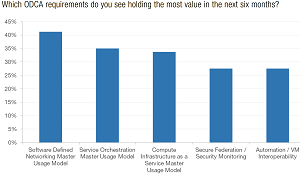News
Cloud Adoption Survey Points to SDN Demand
The latest membership survey from the Open Data Center Alliance (ODCA) shows increased use of software-defined networking (SDN) technologies with even more demand forecast for the near future.
The ODCA coordinates open cloud computing development standards, providing usage models that include global requirements for datacenter and cloud solutions with detailed documentation about deploying technology based on those requirements. The usage model requirements can help organizations develop requests for proposals (RFPs) and specifications for new cloud implementations.
Founded in 2010, the organization -- including companies such as BMW, Capgemini, Coca-Cola, SAP and dozens of others -- has conducted annual surveys of its membership to discern cloud computing interests and trends to help further its cause of accelerating cloud adoption.
A major trend revealed in the latest survey is the growing use of and further interest in SDN usage models.
"This year showed a marked increase in the use of the ODCA's SDN usage model and a preference for that usage model in the coming six months," the organization said in a statement announcing the publication of its fourth membership survey.
 [Click on image for larger view.]
Looking Out Six Months (source: ODCA)
[Click on image for larger view.]
Looking Out Six Months (source: ODCA)
SDN, a new-age networking virtualization technology that separates networking layers with a centralized management approach and allows for increased network programmability and use of cheaper commodity hardware, provides the following benefits, according to the ODCA usage model:
- Separation of the physical network from the logical network.
- Simplified and more centrally controlled network management, automation and (potentially) programmability.
- Greater virtual machine (VM) mobility across the datacenter.
- Enhanced security capabilities.
- Better traffic segmentation.
- Dynamic network partitioning to handle multi-tenant networks.
"SDN is a nascent field and new use cases, operational models, common practices, tools and services are constantly emerging and will rapidly evolve," the usage model document states. "Initially, vendors and early adopter cloud providers will differentiate themselves by offering new capabilities and services, but there will be little interoperability and standardization."
However, with interoperability and standardization efforts underway by the ODCA and other organizations, SDN is gradually seeing more real-world use cases, as reflected in the new membership survey.
"The survey, conducted at the end of 2014, revealed a current preference among members for internal cloud solutions," the organization stated. "However, their growing interest in SDN and hybrid cloud suggests future movement towards solutions that blend public and internal resources."
The SDN usage model saw the biggest increase in interest over last year's survey, exhibiting a whopping 32 percent uptick, far ahead of the 21 percent second-place increase for security monitoring. It terms of total interest -- not the increase in interest -- SDN was just one percentage point behind the top response -- Compute Infrastructure as a Service -- in a question asking what usage models were being used for RFP integration.
"Looking forward to the next six months, the top usage model is forecasted to be SDN, topping compute IaaS and service orchestration," the survey stated.
Other data points in the survey indicate more than 80 percent of respondents are planning to use hybrid cloud solutions. "Over the past three years, there has been significant growth in internal cloud implementations, with the greatest growth in organizations that have more than half of their services in private clouds," the ODCA said in an accompanying news release.
Other survey data highlighted by the ODCA include:
- Since 2012, the number of respondents who have greater than 60 percent of their operations in an internal cloud has increased from 10 percent to 24 percent.
- Respondents with one-fifth or less of their operations in internal cloud services dropped 23 percent, implying a push of operations further up the stack.
- The primary concern that slows cloud adoption continues to be security.
- For the past three years, the amount of organizations with less than 20 percent of their operations in a public cloud has ranged from 79 percent to 88 percent.
The ODCA polled current and past organization members starting in December 2014 with electronic invitations. "The objectives of the survey are to track adoption of cloud services, track integration of ODCA requirements into deployment plans, and identify shared outlooks on technical obstacles facing enterprise use of cloud services and data analytics," the ODCA said. "It reveals what these companies are doing with the cloud."
About the Author
David Ramel is an editor and writer at Converge 360.